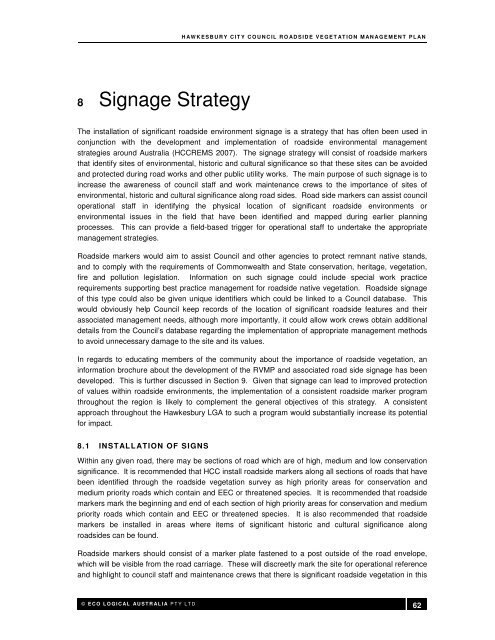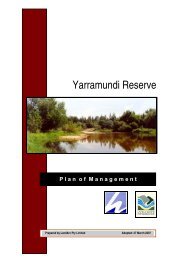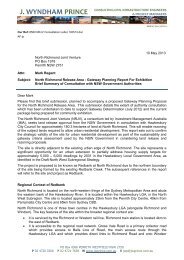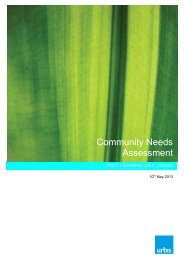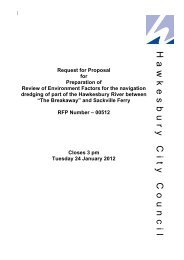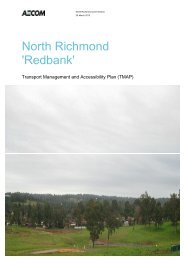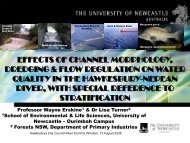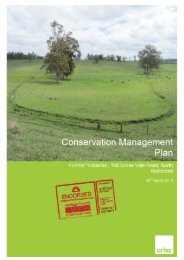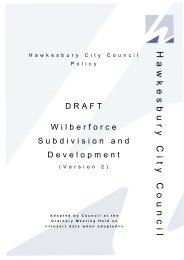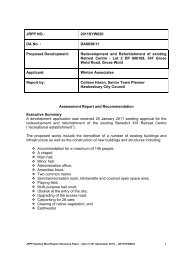Attachment 1 to Item 53 - Roadside Vegetation Management Plan
Attachment 1 to Item 53 - Roadside Vegetation Management Plan
Attachment 1 to Item 53 - Roadside Vegetation Management Plan
You also want an ePaper? Increase the reach of your titles
YUMPU automatically turns print PDFs into web optimized ePapers that Google loves.
H AW K E S B U R Y C IT Y C O U N C IL R O AD S ID E V E G E T AT IO N M AN AG E M E N T P L AN<br />
8 Signage Strategy<br />
The installation of significant roadside environment signage is a strategy that has often been used in<br />
conjunction with the development and implementation of roadside environmental management<br />
strategies around Australia (HCCREMS 2007). The signage strategy will consist of roadside markers<br />
that identify sites of environmental, his<strong>to</strong>ric and cultural significance so that these sites can be avoided<br />
and protected during road works and other public utility works. The main purpose of such signage is <strong>to</strong><br />
increase the awareness of council staff and work maintenance crews <strong>to</strong> the importance of sites of<br />
environmental, his<strong>to</strong>ric and cultural significance along road sides. Road side markers can assist council<br />
operational staff in identifying the physical location of significant roadside environments or<br />
environmental issues in the field that have been identified and mapped during earlier planning<br />
processes. This can provide a field-based trigger for operational staff <strong>to</strong> undertake the appropriate<br />
management strategies.<br />
<strong>Roadside</strong> markers would aim <strong>to</strong> assist Council and other agencies <strong>to</strong> protect remnant native stands,<br />
and <strong>to</strong> comply with the requirements of Commonwealth and State conservation, heritage, vegetation,<br />
fire and pollution legislation. Information on such signage could include special work practice<br />
requirements supporting best practice management for roadside native vegetation. <strong>Roadside</strong> signage<br />
of this type could also be given unique identifiers which could be linked <strong>to</strong> a Council database. This<br />
would obviously help Council keep records of the location of significant roadside features and their<br />
associated management needs, although more importantly, it could allow work crews obtain additional<br />
details from the Council’s database regarding the implementation of appropriate management methods<br />
<strong>to</strong> avoid unnecessary damage <strong>to</strong> the site and its values.<br />
In regards <strong>to</strong> educating members of the community about the importance of roadside vegetation, an<br />
information brochure about the development of the RVMP and associated road side signage has been<br />
developed. This is further discussed in Section 9. Given that signage can lead <strong>to</strong> improved protection<br />
of values within roadside environments, the implementation of a consistent roadside marker program<br />
throughout the region is likely <strong>to</strong> complement the general objectives of this strategy. A consistent<br />
approach throughout the Hawkesbury LGA <strong>to</strong> such a program would substantially increase its potential<br />
for impact.<br />
8.1 INSTALLATION OF SIGNS<br />
Within any given road, there may be sections of road which are of high, medium and low conservation<br />
significance. It is recommended that HCC install roadside markers along all sections of roads that have<br />
been identified through the roadside vegetation survey as high priority areas for conservation and<br />
medium priority roads which contain and EEC or threatened species. It is recommended that roadside<br />
markers mark the beginning and end of each section of high priority areas for conservation and medium<br />
priority roads which contain and EEC or threatened species. It is also recommended that roadside<br />
markers be installed in areas where items of significant his<strong>to</strong>ric and cultural significance along<br />
roadsides can be found.<br />
<strong>Roadside</strong> markers should consist of a marker plate fastened <strong>to</strong> a post outside of the road envelope,<br />
which will be visible from the road carriage. These will discreetly mark the site for operational reference<br />
and highlight <strong>to</strong> council staff and maintenance crews that there is significant roadside vegetation in this<br />
© E C O L O G I C AL AU S T R AL I A P T Y L T D<br />
62


